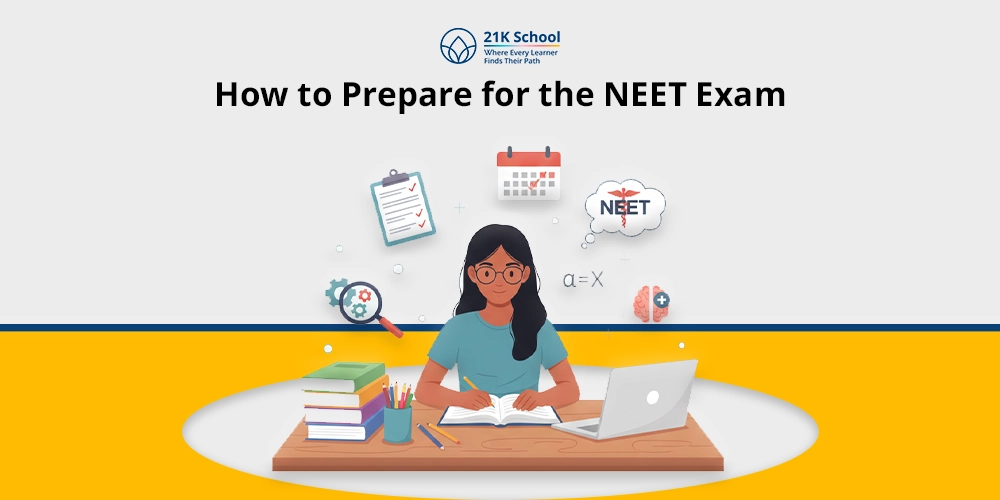
E-learning also commonly referred to as online learning in the present generation’s digital world has transformed education through the delivery of flexible and accessible education to students.
Two primary modes of e-learning have emerged: asynchronous and synchronized courses. It is of significant importance for students, parents, and educators to comprehend the differences between these modes to get the most out of online education.
At 21K School, a leading homeschooling platform where they teach homeschooling curriculum for Indian, US, and UK boards.
They incorporate both synchronous and asynchronous e-learning education systems to meet the needs of our students. Let’s understand about this method of learning precisely.
Contents
Understanding E-Learning
E-learning or electronic learning can be described as the use of Internet facilities with the purpose of learning that is not under the conventional method of classroom learning.
It covers all types of online education
, which may include fully online courses or virtual classes and those that combine both face-to-face and online courses.
The notable advantages of e-learning include the possibilities of taking courses, sharing information, communications, course participation, and communications with instructors and colleagues regardless of their location or time zones.
What Is Synchronous E-Learning?
Synchronous e-learning tends to involve the use of real-time communication among the students and the instructors.
This kind of learning resembles a class setting where the learners and instructors are active at the same time in an online platform.
Synchronous e-learning is the process of learning and teaching using integrated technologies such as video conferencing, live chats, and other interactive webinars.
1. Features:
- Real-Time Interaction: Getting information and answering questions is available to learners and this makes the learning process more flexible and live.
- Structured Schedule: Classes are conducted at a particular period in the day, hence the students have to organise their time according to the class timetable.
- Collaborative Learning: Teamwork, live class discussions, and project-based activities enhance the learning experience.
- Immediate Support: Direct interaction with the tutors is possible; thus, the student can be assisted with any difficulties within the shortest time.
Also Read, Conventional To Innovational Online Learning Experience .
2. What are the Benefits Of Synchronous E-Learning?
i) Enhanced Engagement:
The use of synchronous e-learning implies that learning students are engaged throughout the learning process.
The live sessions, discussions, and questioning sessions are closer to traditional classes, making the learning process engaging not monotonous.
This continuous interaction motivates students to stay focused, reducing the likelihood of procrastination and the resultant lack of concentration.
ii) Immediate Feedback:
The unique benefit that makes asynchronous e-learning attractive include is that students receive instant feedback.
In lectures, students are allowed to ask questions and receive answers in real-time, meaning that they are also able to learn at a fast pace and eliminate misconceptions.
This kind of feedback facilitates learning by making it more effective and faster since it is done in real-time.
iii) Sense of Community:
Live interaction with peers and instructors helps in building good rapport and good social belongingness among students.
Such interactions foster the creation of an environment in which students can freely participate in class discussions and as well carry out group projects and foster relationships with others.
These two can increase students’ morale and in some way contribute to the improvement of the quality of education to be delivered.
iv) Structured Learning:
Synchronous e-learning has a set learning time hence students can learn proper time management skills .
It is much easier to attend classes at a set time and have deadlines because it creates a specific regimen to follow and will not allow a student to be stagnant when it comes to studying.
They also found that structure can be particularly helpful to the student’s situation when they need more of a routine to function at their best.
3. Examples of Synchronous E-Learning
Synchronous e-learning includes real-time interactions between the educators and students.
It copies the traditional classroom approaches with students and teachers present at the same time even though in different locations.
Communication occurs through different ways like video conferencing or virtual classrooms. The immediate feedback and interaction helps in active participation, student engagement, and real-time discussions.
Some common examples of synchronous e-learning are:
- Online Classrooms: Various apps help students and teachers to ensure communication via Zoom or Google Meet. It is a more interactive learning option that enables live lectures, discussions etc.
- Live Online Workshops and Labs: Various subjects such as science and technology, synchronous online workshops allow hands-on activities with guidance. Students can do these simple science experiments at home.
4. Challenges and Solutions for Synchronous E-Learning
Students get some common challenges in synchronous e-learning such as:
i) Challenges
- Limited Flexibility: Limited flexibility means synchronous learning needs students to attend sessions at a specific time frame. This may not accommodate all schedules or priorities.
- Time Management Issues: Due to the vast course, different activities and extracurriculars, students are unable to manage time for each session. This leads to a drawback especially for younger kids.
- Technical Issues: There are many technical issues like internet connectivity problems, software glitches, and other technical challenges that can create disturbance in sessions and affect learning of students.
ii) Solutions
- Proactive Measures: To resolve flexibility issues students can go with solutions such as check session settings and prepare back-up plans.
- Focus on Time Management Techniques: Students need strong time management skills to attend sessions on time and participate effectively.
- Utilize Diverse Learning Tools: However, incorporating effective digital tools and understanding of technology can help students to learn in a better environment and promote participation.
Asynchronous E-Learning
Asynchronous e-learning enables the student to get notes, and assignments or do any learning activity at his/her own chosen time and periodically as he/she wishes.
This mode of learning is very flexible and can suit any learning mode and calendar.
1. Features
- Self-Paced Learning: The learner can learn at their own pace, and they can refresh sections that they may not have understood.
- Flexible Schedule: This is convenient for learners since they can come anytime with or without scheduled time and online is convenient since one does not need to be around a computer at any particular time.
- Diverse Resources: Many media resources such as recorded lectures, discussion forums, and digital books address the multifaceted learning styles.
- Independent Learning: Promotes self-discipline, time-saving, and independent problem-solving
2. What are the Benefits Of Asynchronous E-Learning?
i) Flexibility:
Like any other type of distance education, asynchronous e-learning can be characterised by flexibility since a student can take a course at any convenient time and complete the work at the same time.
By availing time to the students, they can easily organize their learning schedule to fit their everyday activities hence no pressure.
ii) Accessibility:
Asynchronous e-learning is flexible and free from geographical and time zone barriers since learning resources are available at any time.
Thus, students from different countries can be provided the same quality of education as the students of their chosen country.
Also Read, Helping Affordable Online Schools Provide Quality Education .
Such accessibility proves that more learners will have an equal shot at achieving their dreams to advance the diversity of learners in the academic society.
iii) Personalised Learning:
Flexible and convenient Asynchronous e-learning enables the students to make their schedule, thus they follow what they prefer most.
They have control over where, when, and what they do, they can opt to review areas that they think require more of their time.
This makes learning very much a student-centered and individual activity and, thus, more effective since students are in charge of their learning.
iv) In-Depth Understanding:
Perhaps, one unique advantage to asynchronous e-learning that has not been discussed is the ability to go through the material more than once.
Content can be viewed and reviewed as many times as required to grasp and understand the information provided.
It is a good practice because it aids in an improved understanding of the material, especially when such material is rather bulky and difficult to learn.
3. Examples of Asynchronous E-Learning
Asynchronous e-learning is ideal for individuals balancing education with other responsibilities. Some of the common example are:
- Email Communication: With the help of email communication students can easily reach out to teachers with queries and receive solutions without being online simultaneously.
- Pre-recorded Videos And Lessons: Students and even teachers can watch the pre-recorded videos and lessons or complete modules on their own schedules, pausing and rewinding as needed.
- Online Quizzes and Assignments: Learning Management Systems (LMS) like Moodle or Blackboard are ideal options to complete and submit assessments at their own pace.
4. Challenges and Solutions for Asynchronous E-Learning
Some common challenges and solutions of asynchronous e-learning are:
i) Challenges
- Lack of Interaction and Social Connection: With the help of asynchronous learning students feel isolated as compared to traditional classrooms. In a traditional classroom setting the opportunities for face-to-face interactions and real-time discussions are ideal for social connections.
- Limited Feedback and Support: This kind of learning can delay the receipt of feedback on classroom, projects, assignments and inquiries. This ultimately hinders the progress of students’ education and delays clarification of concepts.
- Difficulty Maintaining Motivation: Self-directed learning needs a high degree of discipline and motivation from students which can be easily lacking sometimes. It is a challenging task for students without the structure and guidance of a traditional classroom.
ii) Solutions
- Interactive E-Learning Content: By using multimedia elements such as interactive videos, simulations, and interactive quizzes increase students’ engagement and make the learning experience more dynamic and attractive.
- Leverage LMS Platforms: With the guidance of Learning Management Systems (LMS) teachers can facilitate communication, track progress, and provide access to resources for better connection and feedback.
- Encourage Collaboration and Communication: By online discussion forums, group projects, and collaborative activities lack of motivation can be managed. It helps to foster a sense of community and allow students to interact with each other and teachers.
Combining Synchronous and Asynchronous E-Learning at 21K School
At 21K School, we understand the advantages of both forms of e-learning thus offering complete and convenient learning processes.
Blended Learning Model
To be precise, our vision of blended learning enables students to acquire the two in moderation to benefit from the better part of face-to-face learning and even the better part of Online learning.
- Scheduled Live Classes: If there are lectures and live classes are conducted, the students get to engage themselves in a discussion with the tutor and get feedback instantly with real-time interaction.
- Flexible Learning Resources: Lectures that are taken during the class and notes, digital textbooks, and other informative materials are provided to the students whenever they need them.
- Interactive Assignments: Real-time assignments as well as self-paced assignments help develop an equal balance of both teamwork and individual work along with improvised time management skills.
- Continuous Support: We have our teachers who can help you individually or whenever you need assistance regarding the course.
Conclusion
It can be concluded that both asynchronous and synchronous e-learning, despite having differences, can also have advantages that can positively contribute to the process of educating.
Platforms like 21K School, have incorporated the above-mentioned modes to offer flexibility, effectiveness, and engagement for the success of our students.
Thus, being aware of the strengths of each method and using each as designed allows our students to receive a balanced and fruitful education.
To learn more about the solutions that 21K School has to offer for your child, please go to our website and learn more about our homeschooling programs.


